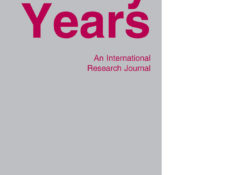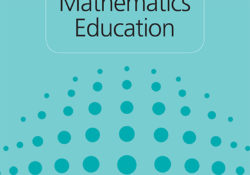eric.ed.gov har udgivet: In this paper we introduce the term “task science” to encompass the range of activities involved in designing tasks for school mathematics. We argue that task science is enriched by the participation of teachers, but more particularly that participating in task science is a powerful form of professional learning. We describe the role and design of task science in the reSolve: Maths by Inquiry project, and give examples of how teachers’ involvement in each phase of the process was both critical in developing the resources and promoted rich professional learning. Link til kilde
Like this:
Like Loading...
tandfonline.com har udgivet en rapport under søgningen “Teacher Education Mathematics”: ABSTRACT ABSTRACT In mathematics education, digital tools have been used to enhance young children’s understanding of specific subject matter. In such implementations, the digital tool can replace, amplify or transform ‘ordinary’ mathematics teaching. In an initial study, systematization and duplication were identified as critical when young children were to solve a combinatorial task. Therefore, a digital version of the task was developed and combined with a non-digital version, to introduce the use of dual artefacts. The digital version of the task enabled the children to visually explore systematization as well as the principle of completion. After using this digital version of the task, the children’s written records became more systematic and included fewer duplications. We conclude that the digital version… Continue Reading →
Like this:
Like Loading...
eric.ed.gov har udgivet: The aim of this study is to find out whether there is a connection between teacher’s request and guidance for written explanation and third-graders’ achievements in solving a non-standard problem. Pupils’ task was to solve a simplified arithmagon and to explain their solution. The lessons of seven teachers were recorded and their actions were examined and categorized during a problem-solving lesson. Also pupils’ solutions were checked and classified. The teacher’s behavior seems to have a crucial role in the quality of pupils’ written explanations. The third-graders had difficulties in writing their reasoning for solving the problem. Link til kilde
Like this:
Like Loading...
tandfonline.com har udgivet en rapport under søgningen “Teacher Education Mathematics”: ABSTRACT ABSTRACT This article reports on a post hoc study using a randomised controlled trial with 31,842 students in the Netherlands and an instrument consisting of 21 paired problems. The trial showed a variability in the differences of students’ results in solving contextual mathematical problems with either a descriptive or a depictive representation of the problem situation. In this study the relation between this variability and two task characteristics is investigated: (1) complexity of the task representation; and (2) the content domain of the task. We found indications that differences in performance on descriptive and depictive representations of the problem situation are related to the content domain of the problems. One of the tentative conclusions is that for depicted problems… Continue Reading →
Like this:
Like Loading...
eric.ed.gov har udgivet: In this study, we expand the Cohen and Ball triangle of interactions to explore the relationship of professional development to classroom practice. We consider a case study of one teacher’s implementation of a task from professional development in her 7th grade classroom. We were specifically interested in how the content and pedagogy of the professional development would be adopted by the teacher. Our findings suggest that this teacher treated pedagogy and mathematical content as separable, which led to problematic implementation of PD practices. [For the complete proceedings, see ED585874.] Link til kilde
Like this:
Like Loading...
eric.ed.gov har udgivet: To disrupt patterns of marginalization that play out through interactions in math classrooms, teachers need to identify and address inequities in student participation, both in terms of participation outcomes and processes. In this study, I take an expansive view of participation and examine how the “quiet” participation of one 9th grade student is co-constructed through small-group interactions during an Algebra task. Analysis reveals three features of the group’s interactions that fostered the co-construction of Becca’s “quiet” participation: 1. Becca was positioned as a non-contributing silent beneficiary of learning, 2. Becca’s contributions received less support than her peers’, 3. Disagreement with Becca was softer than with John. Findings suggest that the perceived issue of low verbal production did not reside within Becca, but rather was the result of… Continue Reading →
Like this:
Like Loading...
tandfonline.com har udgivet en rapport under søgningen “Teacher Education Mathematics”: Abstract Formulae display:?Mathematical formulae have been encoded as MathML and are displayed in this HTML version using MathJax in order to improve their display. Uncheck the box to turn MathJax off. This feature requires Javascript. Click on a formula to zoom. We examine a group (N = 88) of Swedish first-year engineering students, their motivation, self-efficacy, and beliefs about the nature of mathematics, and how these relate to their task performance in mathematics. In our data, engineering students who emphasized the exact reasoning in their view of mathematics performed significantly better in a set of mathematical tasks than those who emphasized the applications of mathematics. Similarly, the higher self-efficacy and the intrinsic and utility values of mathematics relate to better performance in… Continue Reading →
Like this:
Like Loading...
tandfonline.com har udgivet en rapport under søgningen “Teacher Education Mathematics”: ABSTRACT ABSTRACT It is well known that students benefit from opportunities to interpret and create different representations (e.g., diagrams, graphs, tables, symbols) of mathematical ideas. Employing Marton’s Variation theory as a lens, I argue for an expansion of the use of multiple representations in task design for graphs: Incorporate two different forms of the same type of graph to represent a relationship between variables in a situation. With this approach, designers, teachers, and researchers can engineer opportunities for students to discern, or separate, features of representation systems, such as the Cartesian coordinate system, and in turn, promote students’ mathematical reasoning. Link til kilde
Like this:
Like Loading...
Ucviden.dk har udgivet: Highlights • One of the first quantitative studies on teacher educators’ professional identity. • Valid and empirically reliable measurement of teacher educators’ task perception. • We distinguish between teacher educators as facilitators and transmitters. • Facilitators demonstrate increased self-efficacy. • Teacher educators’ task perception is related to the quality of teacher training. Abstract We assessed teacher educators’ task perception and investigated its relationship with components of their professional identity and their teaching practice. Using data from 145 teacher educators, two different task perceptions were found: transmitters and facilitators. Teacher educators who were categorized as facilitator tend to demonstrate higher levels of self-efficacy, job satisfaction, constructivist beliefs about teaching and learning and use more effective teaching strategies. The findings demonstrate that teaching practices of teacher educators are rooted… Continue Reading →
Like this:
Like Loading...



